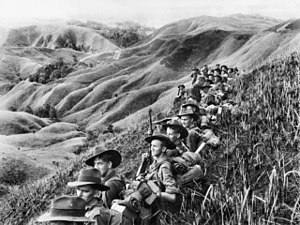| Australian Army | |
|---|---|
 Australian soldiers rest in the Finisterre Ranges of New Guinea while en route to the front line during March 1944 | |
| Active | 1939–1945 |
| Country | Australia |
| Allegiance | Allies |
| Type | Army |
| Size | 80,000 (September 1939) 476,000 (peak in 1942) 730,000 (total) |
| Engagements | World War II |
| Commanders | |
| Notable commanders | Thomas Blamey |
The Australian Army was the largest service in the Australian military during World War II. Prior to the outbreak of war the Australian Army was split into the small full-time Permanent Military Forces (PMF) and the larger part-time Militia. Following the outbreak of war on the 3rd of September 1939, 11 days later, on 14 September 1939 Prime Minister Robert Menzies announced that 40,000 members of the Militia would be called up for training and a 20,000-strong expeditionary force, designated the Second Australian Imperial Force (Second AIF), would be formed for overseas service. Meanwhile, conscription was introduced in October 1939 to keep the Militia at strength as its members volunteered for the AIF. The Australian Army subsequently made an important contribution to the Allied campaigns in the Mediterranean, the Middle East and North Africa fighting the Germans, Italians, and Vichy French during 1940 and 1941, and later in the jungles of the South West Pacific Area fighting the Japanese between late 1941 and 1945. Following the Japanese surrender Australian Army units were deployed as occupation forces across the South West Pacific. Meanwhile, the Army contributed troops to the British Commonwealth Occupation Force (BCOF) in Japan from 1946.
The Army was considerably expanded in early 1942 in response to the Japanese threat to Australia. During this year the Army's strength peaked at eleven infantry divisions and three armoured divisions, and in August 1942 the Army had a strength of 476,000 men. This force was larger than Australia's population and economy could sustain, and its strength was reduced in the second half of the year. Militia units were able to serve outside of Australian territory in the South West Pacific Area from January 1943 after the Defence (Citizen Military Forces) Act 1943 was passed, but few did so. The Army was further reduced by 100,000 members from October 1943 to free up manpower for industry. At the end of 1943 the Army's strength was set at six infantry divisions and two armoured brigades, although further reductions were ordered in August 1944 and June 1945. The Australian Army generally had a long-standing policy of using British-designed equipment, but equipment from Australia, the United States and some other countries was introduced into service in the war's later years. Pre-war doctrine was focused on conventional warfare in a European environment and the Army did not have any doctrine for jungle warfare prior to 1943. In early 1943 the Army developed a jungle warfare doctrine by adapting the pre-war field service regulations to meet the conditions in the South West Pacific.
The demands of combat during World War II led to changes in the composition of Army units. The success of German mechanised units during the invasions of Poland and France convinced Australian defence planners that the Army required armoured units, and these began to be raised in 1941. These units were not suitable for jungle warfare, however, and most were disbanded during 1943 and 1944. Conditions in the South West Pacific also led the Army to convert its six combat divisions to jungle divisions in early 1943 and 1944 with fewer heavy weapons and vehicles. This organisation proved only moderately successful, and the divisions were strengthened for their 1944–45 campaigns. The process of demobilisation began immediately after the end of hostilities in August 1945 and was finally completed on 15 February 1947. A total of 730,000 personnel enlisted in the Australian Army during the war, a figure which represented around 10 percent of the population. Nearly 400,000 men ultimately served overseas, with 40 percent of the total force serving in front line areas. As a proportion of its population, the Australian Army was ultimately one of the largest Allied armies during World War II. Casualties included 11,323 killed in action, 1,794 who died of wounds, and 21,853 wounded. Another 5,558 were killed or died as prisoners of war (POWs), while non-battle casualties in operational areas were also significant and included 1,088 killed and 33,196 wounded or injured. In addition, the Army suffered a substantial number of casualties in non-operational areas: 1,795 soldiers killed and 121,800 wounded or injured.
© MMXXIII Rich X Search. We shall prevail. All rights reserved. Rich X Search
